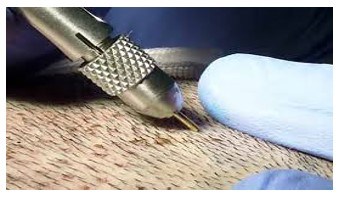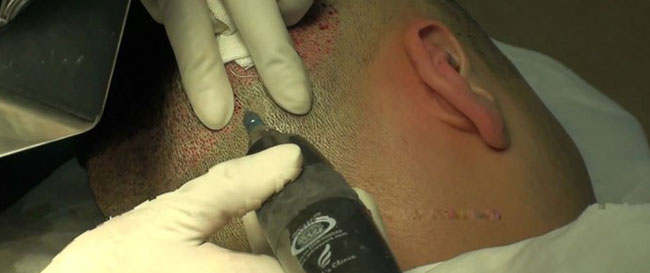In our day and age hair holds more importance anyone realizes until that hair begins to fall out. Then suddenly, the true importance of hair in your life and it’s effect on your confidence is known. In addition to improving your career prospects and social relations, hair may give you an edge in a tight job market. This can make the difference between getting hired and not getting hired. Any advantage helps when the field is competitive. Getting hair restored can help make people more marketable as well as more confident in their overall appearance.
The same goes for hair. Men with fuller heads of hair exude more confidence and may be more successful in their careers.
The good news is a well-done hair transplant can be virtually undetectable when performed expertly by an experienced surgeon and team. For optimal results, it is best to choose a board-certified specialist who devotes himself to hair surgery and is familiar and proficient with ‘follicular unit extraction’ (FUE)
In today’s world the importance of hair is virtually unparalleled, so if you have begun to lose yours know that there is a solution and that solution is a hair transplant.
Definition of FUE
Follicular Unit Extraction (FUE) is the most scientific recent & advanced technique of hair restoration. In this procedure:
- Hair follicles are extracted individually from the back side of the head, beard or other body parts with the help of special micropunches (size varying from 0.7mm – 1.0mm).
- Implanted in the bald area of scalp, beard, moustache, eyebrows or chest.
- These transplanted hairs grow, you can get a haircut and style them in whatever way you want.
Also read Bio FUE and BHT
Advantages of FUE
- Stitch less
- No linear visible scar
- No infection or reaction to sutures
- The patient can wear short hair
- Virtually painless
- Less dependency on assistants for results
- Resume work the next day
- No admission needed
Donor Area
The hair in the scalp are arranged in the form of groups called grafts. Each graft consists of 1-5 hair. These grafts are removed from the permanent zone of back and sides of the head. The hair in these grafts do not have testosterone receptor in the area of the hair root and do not respond to the male hormone, testosterone. Once these are implanted on bald area on front of scalp, they don’t get affected by testosterone and stay permanently. Also other sources of hair include: beard, chest, abdomen, legs. We have mastered the art of removing the grafts with minimal damage.
Recipient Area
The bald area which we want to cover is called recipient area. Grafts (containing 1-4 follicles) taken from donor area are then implanted in the recipient area. Different sizes of grafts are inserted in different parts of the scalp for more fuller and natural look. Giving proper direction to implanted hairs is important to get more natural look.
Growth of transplanted hair after surgery

The transplanted hairs grow for 2-3 weeks, then the hair shafts fall off, the roots remain in the scalp and the shafts start coming back after 2-3 months of surgery.
The hair comes back at a very slow pace and a great deal of patience is required during this period. About 40-50% hairs come back after 6 months and 75% after 9 months and about 90% of transplanted hairs come back after 1 year of surgery.
Why choose us
- State of the art hair transplant centre
- Well trained MD Dermatology doctor with special training in hair transplant
- Dedicated and well trained and experienced staff
- Complete sterile operation theatre and with all aseptic precautions to avoid any infection
- Standard surgery protocols are followed
- Best results – It is ultimately the results that matter.
- Quality preferred over Quantity.
- 100% transparency at all levels – Grafts given by counting.
- We deliver what we promise
Faq’s of Hair Transplant
Q. What is hair transplant?
Hair Transplant is the only permanent method of hair restoration in which one’s own hair from the back and sides of the head are extracted and implanted on front in the bald area.
Q. Who can undergo hair transplant?
- Age of the patient should be 23 yrs or older.
- Inadequate response to medications.
- Significant hair loss.
- Other causes of Hair Loss have been ruled out.
- No medical contraindications to surgery.
- Reasonable patient expectations.
Q. Can females undergo hair transplant?
Yes. Any female with advanced hair loss and visible scalp can undergo
Q. What are the techniques of hair transplant?
Nowadays, hair transplant is being done by Follicular unit technique which involves two ways of hair extraction – STRIP method and FOLLICULAR UNIT EXTRACTION ( FUE).
In the STRIP method, a strip of skin from the back of head (donor area) is removed with the help of scalpel. The gap at the back of head is then sutured together. The strip is then divided into grafts containing one, two or three follicles.

FUE – Follicular Unit Extraction: A stitches method of hair restoration in which hair root (follicles) are extracted from the back of head under local anesthesia with the help of special micro punches and implanted in the bald area. In this procedure, no scalpel is required which is used for cutting skin in the ‘strip’ surgery. The entire procedure is done by the surgeons and not by technicians.no need for stitches and carrying dressing for long time.
 Q. What is the difference between FUE and Strip method?
Q. What is the difference between FUE and Strip method?
Both are methods of hair extraction where in one case whole strip of hair bearing skin is removed and defect sutured back whereas in FUE individual follicles are extracted.
| Strip Hair Transplant | FUE Hair Transplant | |
| Stitch | Cutting open the skin and closing it with stitches So can have stitch related problems | No stitches Minimally invasive |
| Scar | Stitches leave permanent scar at the back of the head. You cannot keep your hair short because the scar will be visible | Multiple pin head tiny marks which are not visible even if you keep you trim your hair to the size “0” |
| Stretching of scar | Can prolong healing period and one has to avoid physical activity for weeks | No such problem and one can start physical activity soon after transplant |
| Recovery | 2 – 3 weeks usually need 1 month of rest for atheletes, body builders etc | 3-4 days. Exercise, weight training, sports, can be resumed in 4-5 days |
| Donor complications | Not uncommon e.g. wide scar, painful scar, delayed healing of stitches and give away of stitches | Practically nil |
| Short hair style | Scar becomes visible, so sporting long hair style is mandatory | Can easily sport short hair style |
| Numbness above stitches | Numbness above the stitches often last for months or permanently due to division of nerves in the line of cut | No numbness because there is no division of nerves |
| Pain in the stitches | Pain for 10-30 days and sometimes even permanently due to entrapment of nerve in the area of cut | Practically no post operative pain |
| Tightness in the donor area | Common for few months | Nil |
| Blood loss in surgery | More | Minimal |
| Operation time | Less | More |
| Donor hair availability | 3000 and sometimes 3500 in one sitting Usually not more than 6000 in two or three sittings | 5000 in one sitting Could be even more than 10,000 with body hair transplant |
| For grey hairs | Difficult to visualize and can have more transactions | Procedure and transaction rate remains unchanged with grey hairs |
| For limited or poor donor area | You cannot select good number of 3 and 4 hair grafts | Maximum number of 3 and 4 hair grafts can be selected to increase the number of transplanted hairs |
| For patients with tight scalp | Larger sessions and multiple sittings become difficult | Ideal method |
| For patients with tight scalp | Larger sessions and multiple sittings become difficult | Ideal method |
| Shock loss | More chances due to more invasive nature of procedureesp in the donor area | Rare, due to minimally invasive nature of the procedure |
| For those with more risk of scarring like Asians | More chances of stretched out scar and hypertrophic scar | Minimum such chances |
| Control on graft harvesting | It is possible that the strip may have less or more hairs than pre calculated | You can calculate and control the exact number of grafts extraction as you wish |
| Special advantages | • With FUE, you can select single hair or multiple hair follicle when needed • In patients with tight scalp or multiple strip scar only FUE is effective • FUE can correct scarring caused by strip technique |
|
| Time for transplant | 3000 grafts in 5 hours | 3000 grafts in 10 hours |
| Surgeons time | Surgeon spends 20% of time Technicians spend 80% of time on the procedure | Surgeon spends 80% of time Technicians spend 20% of the time on the procedure |
Q. In which cases is FUE better than STRIP Technique?
FUE can be done in all cases.
It is most useful for people who keep small hair or shave their head or have tendency of hypertrophic scars because they will not have any visible scars (As they are only Microscopic).
This is the only method by which adequate cover can be given for NH Gr VI-VII as the hair can be extracted from the head as well as the body in multiple sittings.
In the strip technique, the number of hairs are limited as only those hairs which are removed in the strip can be used for transplant.
It is also the preferred technique for eyebrow or moustache transplant or in patients having tight skin.
It is ideal for revision cases i.e. those who have already undergone surgery by strip method. Multiple sittings can be given on consecutive days or later on to give “add-on” hair.
Q. What is the difference between hair and follicular units?
Hair grows naturally in follicular units of one, two or three groups which if extracted together grow in a very natural way.
Q. Does it hurt?
Hair transplant is done under local anaesthesia all over the world which is administered with very fine insulin syringes which hurt minimally. Also we administer nerve blocks which cut down the number of pricks considerably and lead to prolonged anaesthesia. The surgery per se is painless.
Q. What is the time gap between individual sittings?
Individual sittings of FUE can be planned according to the time available. They can be done even on consecutive days or few days or a week apart whereas in the strip, you have to wait for 6-12 months.
Q. What is the difference in the post-op precautions of both techniques?
In STRIP method, sutures are put at the back of head, so special precautions like sleeping in a particular position, refraining from exercise, avoiding strenuous work etc. are required till the stitches are out.
In FUE, the patient walks out of the clinic, rests for a while and is free to follow daily routine from next day. Even the bandage at the back of head is out the next day. As there are no sutures there is minimal pain post operatively.
Q. Is there any difference in the no. of follicles extracted by these methods?
Yes, the number of follicles extracted in STRIP method is definitely more in one sitting as compared to one sitting of FUE. But even one sitting of strip is usually not sufficient for most of the cases which means multiple sittings and multiple scars. FUE is virtually free of scars (As they are only Microscopic) and patient can undergo multiple sittings without much discomfort.
Q. What about the scarring?
Scarring is definitely more in STRIP method and sometimes numbness and abnormal sensation persists at the back of head.
Q. What about the healing period?
Healing is much faster in FUE and patient is active and mobile immediately after surgery on the same day only whereas in STRIP a resting period of at least a week is required.
Q. When will the scabs fall off?
The scabs at the back of head and at front fall off after 7-10 days and one cannot even make out the sites from where the grafts have been taken after 2 weeks. When can one see the final results?
Q. when hairs start regrown?
The hair starts regrown after 3-4 months. Full growth is usually appreciable after 10-12 months.
Q. What is the life of transplanted hair?
It is lifetime as the donor area is the permanent zone.
Q. Why is it costly than the Strip method?
FUE the world over is more costly than STRIP as it involves more hard work and more time period is spent. Also the entire procedure is performed by the surgeons themselves unlike STRIP method where the assistants do upto 75% of the work.
Q. How many hairs are required to cover the bald area?
It depends on the bald area as well as the density required by a patient. You can send in your pictures in front-on, sides and from below view for free online consultation and we can advise you regarding the same.
Q. Does the transplanted hair look natural?
The look is definitely natural as transplant is done by FOLLICULAR UNIT method where naturally growing groups are taken out and implanted as compared to the outdated punch transplant where the look was not natural.


